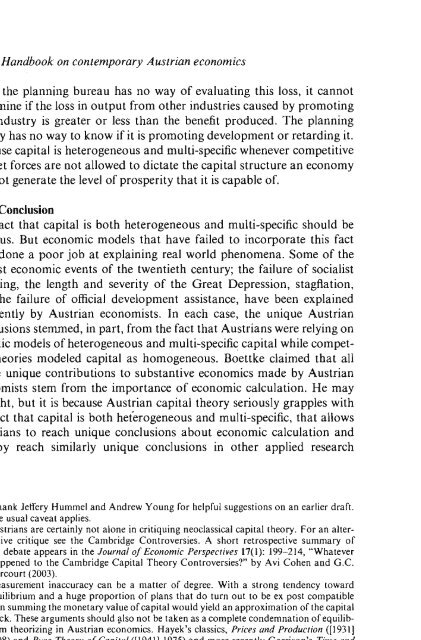Handbook on Contemporary Austrian Economics
Handbook on Contemporary Austrian Economics
Handbook on Contemporary Austrian Economics
Create successful ePaper yourself
Turn your PDF publications into a flip-book with our unique Google optimized e-Paper software.
134 <str<strong>on</strong>g>Handbook</str<strong>on</strong>g> <strong>on</strong> c<strong>on</strong>temporary <strong>Austrian</strong> ec<strong>on</strong>omics<br />
Since the planning bureau has no way of evaluating this loss, it cannot<br />
determine if the loss in output from other industries caused by promoting<br />
<strong>on</strong>e industry is greater or less than the benefit produced. The planning<br />
agency has no way to know if it is promoting development or retarding it.<br />
Because capital is heterogeneous and multi-specific whenever competitive<br />
market forces are not allowed to dictate the capital structure an ec<strong>on</strong>omy<br />
will not generate the level of prosperity that it is capable of.<br />
9.6 C<strong>on</strong>clusi<strong>on</strong><br />
The fact that capital is both heterogeneous and multi-specific should be<br />
obvious. But ec<strong>on</strong>omic models that have failed to incorporate this fact<br />
have d<strong>on</strong>e a poor job at explaining real world phenomena. Some of the<br />
biggest ec<strong>on</strong>omic events of the twentieth century; the failure of socialist<br />
planning, the length and severity of the Great Depressi<strong>on</strong>, stagflati<strong>on</strong>,<br />
and the failure of official development assistance, have been explained<br />
coherently by <strong>Austrian</strong> ec<strong>on</strong>omists. In each case, the unique <strong>Austrian</strong><br />
c<strong>on</strong>clusi<strong>on</strong>s stemmed, in part, from the fact that <strong>Austrian</strong>s were relying <strong>on</strong><br />
realistic models of heterogeneous and multi-specific capital while competing<br />
theories modeled capital as homogeneous. Boettke claimed that all<br />
of the unique c<strong>on</strong>tributi<strong>on</strong>s to substantive ec<strong>on</strong>omics made by <strong>Austrian</strong><br />
ec<strong>on</strong>omists stem from the importance of ec<strong>on</strong>omic calculati<strong>on</strong>. He may<br />
be right, but it is because <strong>Austrian</strong> capital theory seriously grapples with<br />
the fact that capital is both heterogeneous and multicspecific, that allows<br />
<strong>Austrian</strong>s to reach unique c<strong>on</strong>clusi<strong>on</strong>s about ec<strong>on</strong>omic calculati<strong>on</strong> and<br />
thereby reach similarly unique c<strong>on</strong>clusi<strong>on</strong>s in other applied research<br />
areas.<br />
Notes<br />
* I thank Jeffery Hummel and Andrew Young for helpful suggesti<strong>on</strong>s <strong>on</strong> an earlier draft.<br />
The usual caveat applies.<br />
I. <strong>Austrian</strong>s are certainly not al<strong>on</strong>e in critiquing neoclassical capital theory. For an alternative<br />
critique see the Cambridge C<strong>on</strong>troversies. A short retrospective summary of<br />
the debate appears in the Journal of Ec<strong>on</strong>omic Perspectives 17(1): 199- 214, "Whatever<br />
Happened to the Cambridge Capital Theory C<strong>on</strong>troversies" by Avi Cohen and G.c.<br />
Harcourt (2003).<br />
2. Measurement inaccuracy can be a matter of degree. With a str<strong>on</strong>g tendency toward<br />
equilibrium and a huge proporti<strong>on</strong> of plans that do tum out to be ex post compatible<br />
then summing the m<strong>on</strong>etary value of capital would yield an approximati<strong>on</strong> of the capital<br />
stock. These arguments should ~Iso not be taken as a complete c<strong>on</strong>demnati<strong>on</strong> of equilibrium<br />
theorizing in <strong>Austrian</strong> ec<strong>on</strong>omics. Hayek's classics, Prices and Producti<strong>on</strong> ([1931)<br />
2008) and Pure Theory of Capital ([1941) 1975) and more recently Garris<strong>on</strong>'s Time and<br />
M<strong>on</strong>ey (2001) all fruitfully begin with a macroec<strong>on</strong>omic equilibrium analysis of the<br />
capital structure and study deviati<strong>on</strong>s from that equilibrium.<br />
3. This is not to claim that the issue of capital heterogeneity has not been raised in the<br />
mainstream. Certainly Solow and others involved in the Cambridge c<strong>on</strong>troversies did<br />
debate it and there are still attempts by some mainstream ec<strong>on</strong>omists to incorporate

















